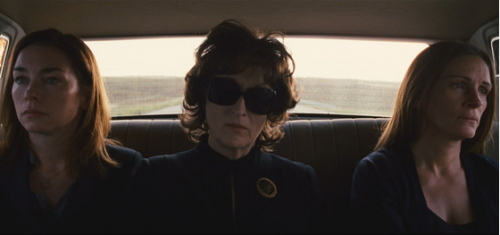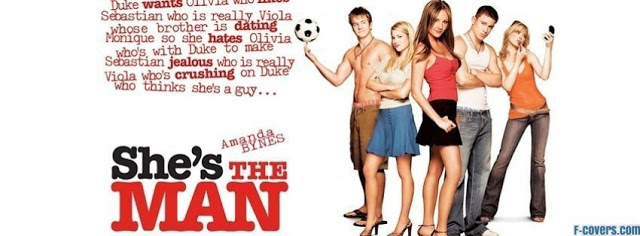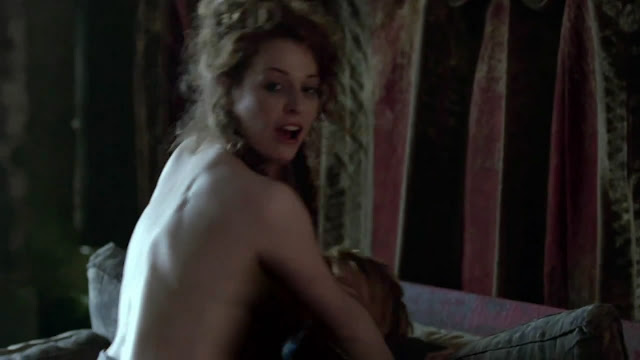August: Osage County has garnered mostly lukewarm reviews. This is somewhat of a surprise: the movie is based on the Pulitzer-winning play by Tracy Letts and the film’s cast is packed with talented actors. Although both Meryl Streep and Julia Roberts were nominated for Golden Globes for their powerful performances, both of them walked away from the award ceremony last Sunday night empty-handed.
But then, this is a movie that is, unambiguously, about women. August: Osage County is about morally flawed, sometimes cruel, and often unlikable women.
And that’s what makes August: Osage County good.
At its essence, the film is about Julia Roberts’ character, Barbara Weston, and her struggle to both claim and reject her identity as a “strong woman.” She inherits her strength from her mother, Violet (Meryl Streep), and it’s a mixture of involuntary responsibility for others and a hardness necessary for survival. At one point midway through the film, Barbara and her two sisters (Julianne Nicholson and Juliette Lewis) sit together discussing their mother. Ivy, the reserved middle sister played by Nicholson, distances herself from affiliation with the rest of the Weston clan by claiming that family is simply a genetic accident of cells. Despite this bit of wishful thinking on Ivy’s part, we see clearly throughout the film that this is far from true. August: Osage County hammers home the idea that our upbringing shapes us no matter how much we may want to escape our complex relationships with our less-than-perfect mothers. The film is deeply evocative of how the familial, social, and physical landscapes of our childhoods leave indelible marks on our adult identities.

In his review for the L.A. Times, Kenneth Turan writes that the film “does nothing but disappoint,” comparing it to “that branch of reality TV where dysfunctional characters… make a public display of their wretched lives.” The problem with the film, according to Turan, is that its high melodrama doesn’t make the audience care about the characters, but instead makes the audience feel trapped.
But, this, I think, is the point. The experience of watching the film is stifling and emotionally difficult, much like the experience of growing up in a dysfunctional, addiction-fueled family like the one we see on the screen. If Turan feels like a voyeur looking in on the “wretched lives” of the Weston family, other viewers of the film will recognize, perhaps with too much familiarity, the uncanny mixture of very dark humor and gut-wrenching trauma at the heart of Weston family life. In the tradition of Faulkner and McCullers, this is a story that holds no punches.
Like Turan, New York Times’ critic A.O. Scott reviewed the film poorly, though he was slightly less negative in his review, writing that it lacked “fresh insight into family relations, human psychology or life on the Plains.” Randy Shulman also gave it an unfavorable review claiming, “The film has one electrifying scene, in which a husband (Chris Cooper) takes his bitchy, critical wife (Margo Martindale) to task. It’s a bracing moment that, for an instant, jolts us out of our lethargy. Had the entire film been on this level of engagement, August: Osage County might have been one of the year’s best films.”
Reading Shulman’s opinion struck me. That same moment in the film was my least favorite scene. I was, indeed, jolted by the scene that Shulman lauds, thinking it seemed too easy in its moral righteousness. It was at that moment of Osage that most of the men in the film (played by Chris Cooper, Sam Shepard, Ewan McGregor, and Benedict Cumberbatch) suddenly seemed to be the innocent and heroic victims of a pack of soul-devouring, child-eating, Gorgon harpies from the hilly plains of Oklahoma. This struck me as strangely out of tune with the rest of the film, which walked the line between making viewers simultaneously despise and sympathize with the women characters who forcefully drive its plot.
The strength of Osage is that it never once sentimentalizes women’s relationships with one another. It does not allow for trite Hollywood portrayals of women as somehow less violent, less complex, or less serious than men. August: Osage County is an odd sort of respite for those of us who don’t relate to stories of quirky, privileged, white girls from Brooklyn. The women of Osage would destroy Girls’ Hannah Horvath with a word and look. For me, it’s a kind of comfort to see these steely women on screen.

Despite its relative strengths, though, the film has one glaring failing: its treatment of race. Actress Misty Upham plays Johnna Monevata, a Native American woman hired at the start of the film to take care of the cancer-stricken, pill-addicted, racist Violet. That Violet is raw and unflinching in her racism against Native Americans isn’t the problem, as this seems realistically in accord with her character. What is an issue though is that the film’s attempt to deal with Native-White race relations in Oklahoma comes off hollow and under-developed. While she was a central figure in the original play, in the film, we never get to know Johnna beyond the fact that she can bake good pies.
While most of the narrative is so adept at portraying the mixture of intimacy and violence in the Weston household, the relationship between Johnna and the rest of the characters is flat. Toward the very end of the film, a disoriented and distraught Violet seeks solace and comfort from Johnna. This scene could have been a striking commentary on the way that people of color are often compelled within racist social structures to provide emotional labor and physical care for white people when their own kin will not. If this was the intended subtext of Johnna’s presence in the story, her character ultimately registers more like a problematic aside to the “real” action of the white characters in the film. This is really a missed opportunity for a film that is otherwise so successful at highlighting the complexities of being a strong woman from the Plains.
Dr. Lisa C. Knisely is a freelance writer and an Assistant Professor of the Liberal Arts in Portland, Ore.
























